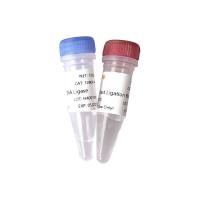DNA Ligation and Escherichia coli Transformation
互联网
888
The generation of recombinant clones usually involves joining together covalently (also called ligating) two or more restriction fragments. This can be done with the enzyme DNA ligase. There are two major sources of the enzyme: Escherichia, coli DNA ligase, which requires Mg2+ and NAD+ as cofactors and is less commonly used, and T4 DNA ligase produced by the E. coli phage T4, which requires Mg2+ and ATP as cofactors. The in vivo function of both these enzymes is to repair nicks in double-stranded DNA, provided there is a 5′-phosphate group and a 3′-hydroxyl group (see Fig. 1 ). Since many restriction enzymes generate sticky ends (Fig. 1 B), ligase will form two covalent bonds to give a single double-stranded fragment. This can be thought of as repairing two nicks. The reaction is usually carried out at 15�C to optimize both the enzymatic activity and the percentage of sticky ends actually in the annealed form. Since this only involves hydrogen bonding between a few base pairs, the dissociation temperature is very low, near 5�C. Unlike E. coli DNA ligase, T4 DNA ligase will also covalently link two blunt-ended molecules (Fig. 1 C), and this reaction can be used to join ends generated by enzymes that do not give sticky ends.







